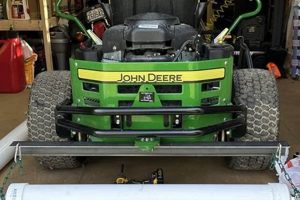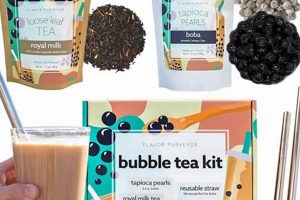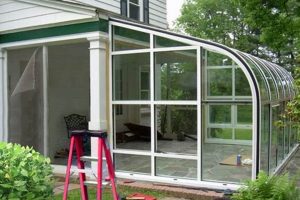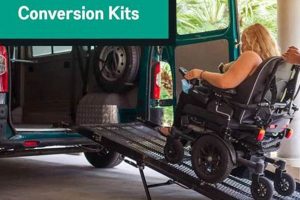A package containing the necessary materials and tools for an individual to apply a vinyl covering to a vehicle’s exterior surface without professional assistance represents a growing segment in automotive customization. These sets typically include vinyl sheets, application tools such as squeegees and knives, and often detailed instructions to guide the user through the wrapping process. For example, a typical set might contain a 5ft x 10ft roll of vinyl, a squeegee, a trimming knife, and a preparation solution.
The appeal of this approach lies in its potential cost savings compared to professional installation and the ability for car owners to personalize their vehicles with a unique finish. Historically, vehicle wraps were exclusively the domain of professional installers, requiring specialized skills and equipment. The introduction of user-friendly kits has democratized the process, offering a more accessible option for enthusiasts seeking to alter their vehicle’s aesthetic. Further benefits include paint protection and the reversibility of the application, allowing for easy removal and restoration to the original factory finish.
Understanding the different types of vinyl available, the proper preparation techniques, and the challenges associated with application is crucial before undertaking such a project. Subsequent sections will delve into these aspects, providing a comprehensive overview of factors to consider before attempting a vehicle wrapping project at home.
Essential Application Strategies
Successful application necessitates careful planning and execution. The following guidelines aim to optimize results and minimize potential complications during the wrapping procedure.
Tip 1: Surface Preparation is Paramount: Thoroughly clean and degrease the vehicle’s surface. Contaminants can compromise adhesion and result in an uneven finish. Isopropyl alcohol is generally recommended for final cleaning.
Tip 2: Employ Heat Strategically: A heat gun or hair dryer is essential for conforming the vinyl to complex curves. However, excessive heat can damage the material. Apply heat in controlled bursts and avoid overheating.
Tip 3: Squeegee Technique Matters: Use a high-quality squeegee and apply consistent pressure to eliminate air bubbles and ensure proper adhesion. Overlapping strokes are recommended to avoid streaking.
Tip 4: Overlap Edges Correctly: When seams are unavoidable, overlap the vinyl by a small margin (approximately 1/8 inch). This prevents gaps from forming due to material shrinkage or stretching over time.
Tip 5: Post-Heating is Crucial: After application, apply heat to the edges and seams to activate the adhesive and ensure a secure bond. This step is particularly important in areas prone to lifting.
Tip 6: Exercise Patience and Precision: Rushing the application process can lead to errors. Take your time and pay close attention to detail to achieve a professional-looking result.
Tip 7: Use Knifeless Tape for Intricate Designs: For complex shapes or graphics, knifeless tape allows for precise cutting without damaging the underlying paint. Follow the manufacturer’s instructions carefully.
Adhering to these suggestions increases the likelihood of achieving a durable and visually appealing vehicle wrap. Careful execution yields long-term benefits and prevents premature failure of the applied film.
The concluding section will offer advice on maintaining the finished product and addressing potential issues that may arise over time.
1. Vinyl Film Quality
Vinyl film quality serves as a cornerstone of any “diy car wrap kit” and exerts a profound influence on both the ease of application and the durability of the final result. Inferior vinyl films frequently exhibit inadequate conformability, leading to difficulties in navigating complex curves and contours of the vehicle. This can result in visible imperfections, such as bubbles or wrinkles, detracting from the aesthetic appeal. Furthermore, low-quality vinyl may possess inadequate UV resistance, causing premature fading, discoloration, or cracking when exposed to sunlight. This directly impacts the longevity of the wrap, potentially necessitating costly replacements in a relatively short timeframe. For instance, a budget-oriented kit with a thin, non-cast vinyl film might prove challenging for a novice to apply smoothly, resulting in a subpar finish prone to peeling within a year. By contrast, a kit containing a high-grade, cast vinyl film will offer greater flexibility, improved adhesion, and enhanced resistance to environmental factors, thereby increasing the likelihood of a successful and long-lasting application.
The choice of vinyl film also affects the ease of repositioning during the application process. High-quality films often incorporate air release channels, facilitating the removal of trapped air and minimizing the occurrence of bubbles. These features are particularly beneficial for individuals with limited experience in vehicle wrapping. Additionally, the adhesive properties of the vinyl play a critical role. A properly formulated adhesive ensures a secure bond with the vehicle’s surface without causing damage to the underlying paint upon removal. However, subpar adhesives may exhibit insufficient tack, leading to lifting or peeling, or conversely, excessive tack, making repositioning difficult and potentially damaging the clear coat. Therefore, the specific type and grade of vinyl included in a car wrapping set is indicative of overall kit quality and the level of user-friendliness.
In summary, vinyl film quality is a paramount consideration when evaluating a “diy car wrap kit”. It is not merely a superficial characteristic but a fundamental determinant of the project’s ultimate success. Selecting a kit with a high-grade vinyl film ensures improved application, enhanced durability, and a more professional-looking finish. Conversely, opting for a lower-quality kit can lead to significant challenges, including application difficulties, premature deterioration, and ultimately, a less satisfactory outcome. The investment in a kit with superior vinyl translates to a long-term benefit, safeguarding the vehicle’s appearance and minimizing the need for future repairs or replacements.
2. Adhesive Properties
The performance of a “diy car wrap kit” hinges significantly on the adhesive properties of the vinyl film. The adhesive must establish a durable bond with the vehicle’s painted surface to prevent lifting, peeling, or bubbling, particularly under varying environmental conditions. Insufficient adhesion can lead to premature failure of the wrap, necessitating reapplication or repairs. For instance, a wrap applied in a climate with high humidity and temperature fluctuations requires an adhesive formulated to withstand these stressors. Failure to account for this can result in edge lifting and compromised visua
l appeal. Conversely, an overly aggressive adhesive may damage the underlying paint upon removal, presenting a different set of problems. The adhesives ability to conform to complex curves and recesses is also critical for achieving a seamless finish.
The type of adhesive employed, whether pressure-sensitive or heat-activated, influences the application process. Pressure-sensitive adhesives offer ease of use but require meticulous surface preparation to ensure optimal bonding. Heat-activated adhesives, while potentially more durable, demand careful temperature control during application to prevent damage to the vinyl or the vehicle’s paint. Furthermore, the adhesive must be resistant to common automotive chemicals, such as gasoline and cleaning agents, to maintain its integrity and prevent degradation of the wraps appearance. For example, exposure to certain solvents can cause the adhesive to soften, leading to discoloration or detachment of the vinyl.
In summary, the adhesive properties are a critical determinant of the success and longevity of any “diy car wrap kit” application. A well-formulated adhesive balances strong bonding strength with ease of removal, resistance to environmental factors, and compatibility with automotive chemicals. Understanding these aspects is essential for selecting the appropriate kit and achieving a professional-looking, durable vehicle wrap. Neglecting these properties leads to unsatisfactory results and potential damage to the vehicle’s finish.
3. Tool Inclusion
The availability of appropriate tools within a “diy car wrap kit” directly influences the outcome and feasibility of the wrapping process. The presence or absence of these tools, along with their quality, determines the ease with which an individual can achieve a professional-looking finish and avoid damage to the vehicle or the vinyl material itself.
- Squeegee Variety and Quality
Different squeegee types are required for various contours and surface areas. A kit should ideally include a hard squeegee for flat surfaces and a softer, more flexible squeegee for curves and edges. Low-quality squeegees can scratch the vinyl or leave residue, while a comprehensive set allows for efficient and damage-free application across the vehicle’s complex geometry. For example, a squeegee with a felt edge is crucial to prevent scratches on the vinyl film during application.
- Cutting Tools: Knives and Trimming Aids
Precision cutting is essential for achieving clean edges and fitting the vinyl around intricate features like headlights or door handles. The inclusion of a sharp, retractable knife, along with specialized trimming tools like knifeless tape, is crucial. A dull knife can tear the vinyl or damage the vehicle’s paint, whereas knifeless tape allows for precise cuts without directly contacting the painted surface, minimizing the risk of scratches or gouges.
- Heat Gun or Heat Source Recommendation
While a heat gun is often not included in the kit itself, instructions or recommendations for a suitable heat source are vital. Heat allows the vinyl to conform to complex curves and tight spaces. Insufficient or improper heating can result in wrinkles, bubbles, or a poorly adhered wrap. Providing guidelines on temperature settings and heating techniques is essential for successful application.
- Surface Preparation Tools and Solutions
Cleanliness is paramount for proper vinyl adhesion. A kit should include or recommend specific cleaning solutions and microfiber cloths suitable for preparing the vehicle’s surface. Contaminants like wax, grease, or dirt can prevent the vinyl from adhering correctly, leading to peeling or bubbling. Clear instructions on surface preparation techniques, alongside the necessary tools, are crucial for a lasting and professional-looking wrap.
These factors concerning tool inclusion highlight the importance of evaluating a “diy car wrap kit” not only on the basis of the vinyl itself but also on the completeness and quality of the accompanying tools and instructions. A well-equipped kit empowers users to achieve a superior result and minimizes the potential for errors or damage during the wrapping process.
4. Instruction Clarity
The efficacy of a “diy car wrap kit” is inextricably linked to the clarity and comprehensiveness of its accompanying instructions. A poorly written or ambiguous instruction manual can transform a potentially straightforward task into a frustrating and error-prone endeavor. This directly impacts the quality of the finished product and the overall satisfaction of the user. The presence of clear, concise instructions serves as a critical component, guiding the user through each step of the application process, from surface preparation to post-application care. Lack of explicit guidance can lead to improper techniques, resulting in bubbles, wrinkles, or peeling, thus negating the cost and time savings the do-it-yourself approach seeks to provide. For example, without clear instructions on the proper use of a heat gun, a user might overheat the vinyl, causing it to stretch excessively or even melt, rendering it unusable.
Well-structured instructions often incorporate visual aids such as diagrams, photographs, or videos to supplement the written text. These visual elements can clarify complex steps and provide a clearer understanding of the techniques involved. Furthermore, effective instructions anticipate potential problems and offer solutions or troubleshooting tips. A common issue in vehicle wrapping is the formation of air bubbles. An instruction manual that anticipates this issue and provides detailed steps on how to remove air bubbles using a squeegee and heat gun significantly increases the likelihood of a successful application. Similarly, clear guidance on how to properly trim the vinyl around door handles, mirrors, and other intricate features ensures a clean and professional finish. Conversely, instructions that omit crucial details or assume a level of prior knowledge can leave users feeling lost and frustrated, ultimately leading to a subpar outcome.
In conclusion, the clarity of instructions is not merely a supplementary element but a fundamental prerequisite for the successful use of any “diy car wrap kit.” The presence of clear, concise, and comprehensive instructions, supplemented by visual aids and troubleshooting tips, empowers users to achieve a professional-looking vehicle wrap and maximizes the potential benefits of the do-it-yourself approach. Conversely, ambiguous or incomplete instructions increase the risk of errors, leading to frustration, wasted materials, and a less than satisfactory result. The importance of instructional design cannot be overstated when considering the user experience and the overall effectiveness of a “diy car wrap kit”.
5. Application Difficulty
The level of challenge inherent in applying a “diy car wrap kit” is a primary factor influencing consumer satisfaction and the quality of the finished product. Several aspects contribute to the overall complexity of the application process, necessitating careful consideration prior to undertaking such a project.
- Vehicle Geometr
y ComplexityThe contours and curves of a vehicle significantly impact application difficulty. Vehicles with numerous complex curves, sharp angles, or deep recesses present a greater challenge compared to those with relatively flat and simple body panels. Applying vinyl film smoothly around intricate features like bumpers, mirrors, and door handles requires advanced techniques and precise execution. Novice users may find such areas particularly problematic, potentially leading to wrinkles, bubbles, or tearing of the vinyl. For instance, wrapping the front bumper of a sports car with aggressive styling presents a significantly greater challenge than wrapping the hood of a sedan.
- Vinyl Film Properties and Conformability
The type of vinyl film included in the kit directly affects its ease of application. Thicker, less conformable films are more challenging to work with, especially around complex curves. Conversely, thinner, more pliable films are easier to stretch and mold but may be more prone to tearing or scratching. High-quality cast vinyl films generally offer superior conformability and durability compared to calendared films, but also command a higher price point. A user with limited experience may struggle to apply a rigid vinyl film to a curved surface without creating unsightly creases or air pockets.
- Environmental Conditions During Application
Ambient temperature and humidity levels can significantly influence the adhesive properties of the vinyl film and its ability to conform to the vehicle’s surface. Extreme temperatures can cause the adhesive to become too sticky or too brittle, making application difficult. High humidity can trap moisture between the vinyl and the paint, leading to bubbles or adhesion problems. Ideally, application should be performed in a controlled environment with moderate temperature and low humidity. Attempting to apply a wrap outdoors on a hot, sunny day or in a damp garage can lead to unsatisfactory results.
- User Skill and Experience Level
Prior experience with vinyl wrapping or similar adhesive applications is a significant advantage. Individuals with experience are more likely to possess the necessary tools, techniques, and problem-solving skills to navigate the challenges of the application process. Novice users may require more time, patience, and practice to achieve a satisfactory result. It is advisable for beginners to start with smaller, less complex panels and gradually progress to larger, more challenging areas. Investing in online tutorials or seeking guidance from experienced wrappers can also significantly improve the chances of success.
These elements underscore the multifaceted nature of application difficulty inherent in “diy car wrap kit”. A careful assessment of vehicle complexity, vinyl film properties, environmental factors, and user skill is paramount before embarking on a DIY wrapping project. By acknowledging these challenges, individuals can make informed decisions about kit selection, preparation, and execution, thereby increasing the likelihood of achieving a professional-looking and durable vehicle wrap.
6. Durability Expectation
The anticipated lifespan of a vehicle wrap applied using a “diy car wrap kit” is a crucial consideration for consumers. This expectation directly influences the perceived value and cost-effectiveness of the chosen kit and the overall satisfaction with the project’s outcome. Several factors contribute to the achievable durability, ranging from material quality to environmental conditions and application precision.
- Vinyl Film Grade and Composition
The grade of vinyl film included in a “diy car wrap kit” is a primary determinant of its longevity. Cast vinyl films, known for their superior conformability and dimensional stability, generally offer a longer lifespan compared to calendared films. For example, a high-quality cast vinyl, properly applied, might be expected to last five to seven years, while a calendared film may only maintain its integrity for one to three years. UV resistance, scratch resistance, and overall thickness contribute to the film’s ability to withstand environmental stressors.
- Adhesive Formulation and Bonding Strength
The adhesive’s ability to maintain a secure bond between the vinyl film and the vehicle’s painted surface is critical for long-term durability. Adhesives formulated to withstand extreme temperatures, humidity, and exposure to automotive chemicals are essential. A weak adhesive may lead to edge lifting, bubbling, or peeling, significantly reducing the wrap’s lifespan. For instance, an adhesive that degrades under prolonged sun exposure may cause the vinyl to delaminate from the vehicle’s surface, requiring costly repairs or replacement.
- Application Technique and Surface Preparation
Proper surface preparation and meticulous application techniques are paramount for maximizing the durability of a “diy car wrap kit”. Thorough cleaning and degreasing of the vehicle’s surface are essential to ensure optimal adhesive bonding. Applying the vinyl with consistent pressure and eliminating air bubbles prevent premature failure. For example, neglecting to properly clean the surface prior to application may leave behind contaminants that interfere with adhesion, leading to bubbling and peeling within a few months.
- Environmental Exposure and Maintenance Practices
The environmental conditions to which the wrapped vehicle is exposed and the maintenance practices employed influence the wraps durability. Prolonged exposure to direct sunlight, extreme temperatures, and harsh weather conditions can accelerate degradation. Regular washing with mild detergents and avoiding abrasive cleaning products help extend the wraps lifespan. For example, consistently parking a wrapped vehicle outdoors in a region with intense sunlight will likely shorten its lifespan compared to a vehicle stored in a garage or carport.
The complex interaction of vinyl grade, adhesive strength, application skill, and environmental factors dictates the realistic durability expectation for a “diy car wrap kit”. Consumers must carefully consider these factors when selecting a kit and executing the application to align their expectations with the achievable lifespan and maintain the wraps appearance over time. Understanding these elements ensures informed decision-making and promotes satisfaction with the chosen vehicle wrapping solution.
7. Cost Effectiveness
The primary driver behind the adoption of a “diy car wrap kit” is often the perceived cost savings compared to professional installation. The financial outlay for materials and tools is typically significantly less than the labor costs associated with hiring a professional wrap installer. For instance, a complete kit might range from $300 to $800, while a professional wrap for the same vehicle could easily exceed $1500, even reaching several thousand dollars for complex designs or high-end materials. This potential for direct cost reduction renders these kits attractive to budget-conscious vehicle owners seeking aesthetic customization or paint protection.
However, a comprehensive understanding of “cost effectiveness” necessitates a deeper analysis beyond the initial purchase price. Factors such as the quality of materials included in the kit, the
skill level of the applicator, and the potential for errors during the application process must be considered. A lower-priced kit may contain inferior vinyl that is more difficult to apply, resulting in material waste, an unsatisfactory finish, or premature failure, ultimately increasing the overall cost. Similarly, an inexperienced applicator may encounter challenges that lead to damage, requiring additional materials or even professional intervention to rectify. Therefore, the true cost-effectiveness is contingent upon balancing the upfront investment with the likelihood of a successful, long-lasting application.
In conclusion, while “diy car wrap kit” solutions offer the potential for significant cost savings, a thorough evaluation of the kit’s contents, the applicator’s skillset, and the vehicle’s complexity is crucial. True cost-effectiveness is realized when a balance is struck between the initial investment and the successful application of a durable and visually appealing wrap. Failure to adequately assess these factors can negate the perceived cost advantage and lead to unexpected expenses, rendering the DIY approach less economically viable than professional installation.
Frequently Asked Questions About DIY Car Wrap Kits
This section addresses common inquiries concerning “diy car wrap kit”, providing clarity on crucial aspects for prospective users.
Question 1: What is the typical lifespan of a vehicle wrap applied using a do-it-yourself kit?
The lifespan varies depending on the quality of the vinyl, environmental conditions, and application technique. Generally, a properly applied wrap using a high-quality kit can last between three to five years. However, exposure to harsh weather or improper application can significantly reduce this timeframe.
Question 2: Are any specialized tools required beyond what is included in the kit?
Most kits include essential tools such as squeegees and trimming knives. A heat gun or hair dryer is often necessary for conforming the vinyl to complex curves, though it is typically not included. Additional tools, like microfiber cloths and isopropyl alcohol, are recommended for proper surface preparation.
Question 3: Can a vehicle wrap be removed without damaging the underlying paint?
Yes, vehicle wraps are designed to be removable. However, the ease and safety of removal depend on the quality of the vinyl and adhesive, as well as the age and condition of the underlying paint. Applying heat during removal can soften the adhesive and facilitate a cleaner release. Caution must be exercised to avoid pulling the vinyl too forcefully, which could potentially damage the paint.
Question 4: Is prior experience necessary to apply a vehicle wrap using a do-it-yourself kit?
While prior experience is beneficial, it is not strictly required. However, novice users should carefully review the instructions and consider practicing on smaller, less complex surfaces before attempting to wrap an entire vehicle. Patience and attention to detail are crucial for achieving a professional-looking result.
Question 5: What are the most common mistakes made when applying a vehicle wrap using a do-it-yourself kit?
Common mistakes include inadequate surface preparation, improper use of heat, trapping air bubbles beneath the vinyl, and imprecise trimming around edges and contours. Thoroughly cleaning the vehicle’s surface, applying heat judiciously, using a squeegee effectively, and taking precise measurements are essential for avoiding these pitfalls.
Question 6: Does a vehicle wrap protect the underlying paint from scratches and fading?
Yes, a vehicle wrap provides a degree of protection against minor scratches, chips, and UV damage. The vinyl film acts as a barrier, shielding the paint from environmental elements. However, it is not a substitute for professional-grade paint protection film and may not prevent damage from severe impacts.
In summary, successful application of a “diy car wrap kit” requires careful planning, meticulous execution, and adherence to best practices. While it offers a cost-effective alternative to professional installation, potential users should carefully weigh their skill level and the complexity of the project before proceeding.
The following section will offer tips for maintaining the finished product and addressing potential issues that may arise over time.
Conclusion
This exploration has illuminated the multifaceted nature of “diy car wrap kit”, detailing the spectrum from material properties and tool requisites to application intricacies and durability considerations. The feasibility and economic advantage of such endeavors hinge upon a confluence of factors: the quality of included materials, the inherent complexity of the vehicle’s design, and the applicator’s proficiency. The pursuit of aesthetic customization or paint preservation via this method demands a rigorous assessment of these variables to mitigate potential pitfalls.
The decision to employ a “diy car wrap kit” should, therefore, transcend mere cost comparison. Prospective users must critically evaluate their capabilities, conscientiously adhere to best practices, and acknowledge the inherent limitations. Only through this measured approach can the promise of a professionally finished, long-lasting vehicle wrap be realized. The responsible application of this technology necessitates informed consideration and diligent execution.







